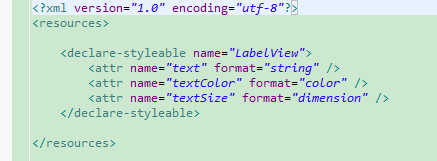自定义View的实现流程


import android.content.Context;
import android.content.res.TypedArray;
import android.graphics.Canvas;
import android.graphics.Paint;
import android.util.AttributeSet;
import android.view.View; /**
* Example of how to write a custom subclass of View. LabelView is used to draw
* simple text views. Note that it does not handle styled text or right-to-left
* writing systems.
*
*/
public class LabelView extends View {
private Paint mTextPaint;
private String mText;
private int mAscent; /**
* Constructor. This version is only needed if you will be instantiating the
* object manually (not from a layout XML file).
*
* @param context
*/
public LabelView(Context context) {
super(context);
initLabelView();
} /**
* Construct object, initializing with any attributes we understand from a
* layout file. These attributes are defined in
* SDK/assets/res/any/classes.xml.
*
* @see android.view.View#View(android.content.Context,
* android.util.AttributeSet)
*/
public LabelView(Context context, AttributeSet attrs) {
super(context, attrs);
initLabelView(); TypedArray a = context.obtainStyledAttributes(attrs,
R.styleable.LabelView); CharSequence s = a.getString(R.styleable.LabelView_text);
if (s != null) {
setText(s.toString());
} // Retrieve the color(s) to be used for this view and apply them.
// Note, if you only care about supporting a single color, that you
// can instead call a.getColor() and pass that to setTextColor().
setTextColor(a.getColor(R.styleable.LabelView_textColor, 0xFF000000)); int textSize = a.getDimensionPixelOffset(
R.styleable.LabelView_textSize, 0);
if (textSize > 0) {
setTextSize(textSize);
} a.recycle();
} private final void initLabelView() {
mTextPaint = new Paint();
mTextPaint.setAntiAlias(true);
// Must manually scale the desired text size to match screen density
mTextPaint.setTextSize(16 * getResources().getDisplayMetrics().density);
mTextPaint.setColor(0xFF000000);
setPadding(3, 3, 3, 3);
} /**
* Sets the text to display in this label
*
* @param text
* The text to display. This will be drawn as one line.
*/
public void setText(String text) {
mText = text;
requestLayout();
invalidate();
} /**
* Sets the text size for this label
*
* @param size
* Font size
*/
public void setTextSize(int size) {
// This text size has been pre-scaled by the getDimensionPixelOffset
// method
mTextPaint.setTextSize(size);
requestLayout();
invalidate();
} /**
* Sets the text color for this label.
*
* @param color
* ARGB value for the text
*/
public void setTextColor(int color) {
mTextPaint.setColor(color);
invalidate();
} /**
* @see android.view.View#measure(int, int)
*/
@Override
protected void onMeasure(int widthMeasureSpec, int heightMeasureSpec) {
setMeasuredDimension(measureWidth(widthMeasureSpec),
measureHeight(heightMeasureSpec));
} /**
* Determines the width of this view
*
* @param measureSpec
* A measureSpec packed into an int
* @return The width of the view, honoring constraints from measureSpec
*/
private int measureWidth(int measureSpec) {
int result = 0;
int specMode = MeasureSpec.getMode(measureSpec);
int specSize = MeasureSpec.getSize(measureSpec); if (specMode == MeasureSpec.EXACTLY) {
// We were told how big to be
result = specSize;
} else {
// Measure the text
result = (int) mTextPaint.measureText(mText) + getPaddingLeft()
+ getPaddingRight();
if (specMode == MeasureSpec.AT_MOST) {
// Respect AT_MOST value if that was what is called for by
// measureSpec
result = Math.min(result, specSize);
}
} return result;
} /**
* Determines the height of this view
*
* @param measureSpec
* A measureSpec packed into an int
* @return The height of the view, honoring constraints from measureSpec
*/
private int measureHeight(int measureSpec) {
int result = 0;
int specMode = MeasureSpec.getMode(measureSpec);
int specSize = MeasureSpec.getSize(measureSpec); mAscent = (int) mTextPaint.ascent();
if (specMode == MeasureSpec.EXACTLY) {
// We were told how big to be
result = specSize;
} else {
// Measure the text (beware: ascent is a negative number)
result = (int) (-mAscent + mTextPaint.descent()) + getPaddingTop()
+ getPaddingBottom();
if (specMode == MeasureSpec.AT_MOST) {
// Respect AT_MOST value if that was what is called for by
// measureSpec
result = Math.min(result, specSize);
}
}
return result;
} /**
* Render the text
*
* @see android.view.View#onDraw(android.graphics.Canvas)
*/
@Override
protected void onDraw(Canvas canvas) {
super.onDraw(canvas);
canvas.drawText(mText, getPaddingLeft(), getPaddingTop() - mAscent,
mTextPaint);
}
}
自定义View的实现流程的更多相关文章
- 自定义View分类与流程
自定义View分类与流程(进阶篇)## 转载出处: http://www.gcssloop.com/customview/CustomViewProcess/ 自定义View绘制流程函数调用链(简化版 ...
- Android查缺补漏(View篇)--自定义 View 的基本流程
View是Android很重要的一部分,常用的View有Button.TextView.EditView.ListView.GridView.各种layout等等,开发者通过对这些View的各种组合以 ...
- 自定义View的基本流程
1.明确需求,确定你想实现的效果2.确定是使用组合控件的形式还是全新自定义的形式,组合控件即使用多个系统控件来合成一个新控件,你比如titilebar,这种形式相对简单,参考:http://blog. ...
- 从一个简洁的进度刻度绘制中了解自定义View的思路流程
先看效果(原谅我的渣像素),进度的刻度.宽度.颜色可以随意设定: [项目github地址: https://github.com/zhangke3016/CircleLoading] 实现起来并不难, ...
- 自定义View(1)简单流程及示例模板
1,继承View , ViewGroup,或TextView等等 2,绘制相关的api, canvas 画布, paint 画笔 2,重写重要的函数(注意这个顺序) onMeasure 属于View的 ...
- 自定义控件(视图)2期笔记01:自定义控件之自定义View的步骤
1. 根据Android Developers官网的介绍,自定义控件你需要以下的步骤: (1)创建View (2)处理View的布局 (3)绘制View (4)与用户进行交互 (5)优化已定义的Vie ...
- Android -- 自定义view实现keep欢迎页倒计时效果
1,最近打开keep的app的时候,发现它的欢迎页面的倒计时效果还不错,所以打算自己来写写,然后就有了这篇文章. 2,还是老规矩,先看一下我们今天实现的效果 相较于我们常见的倒计时,这次实现的效果是多 ...
- Android查缺补漏(View篇)--自定义View利器Canvas和Paint详解
上篇文章介绍了自定义View的创建流程,从宏观上给出了一个自定义View的创建步骤,本篇是上一篇文章的延续,介绍了自定义View中两个必不可少的工具Canvas和Paint,从细节上更进一步的讲解自定 ...
- 自定义View实战--实现一个清新美观的加载按钮
本篇文章已授权微信公众号 guolin_blog (郭霖)独家发布 在 Dribble 上偶然看到了一组交互如下: 当时在心里问自己能不能做,答案肯定是能做的,不过我比较懒,觉得中间那个伸缩变化要编写 ...
随机推荐
- Daily Scrum 11
今天我们小组开会内容分为以下部分: part 1: 针对学长的搜索算法进行优化,每人发表自己的看法; part 2:对积分系统.防滥用.搜索算法优化部分代码任务的讨论和分工: part 3:进行明日的 ...
- alpha-4
前言 失心疯病源4 团队代码管理github 站立会议 队名:PMS 530雨勤(组长) 今天完成了那些任务 19:00~21:50 利用背景相减法完成背景构建与更新模块,查找关于blob更多的论文资 ...
- 《剑指offer》---跳台阶问题
本文算法使用python3实现 1. 问题1 1.1 题目描述: 一只青蛙一次可以跳上1级台阶,也可以跳上2级.求该青蛙跳上一个n级的台阶总共有多少种跳法. 时间限制:1s:空间限制:3276 ...
- 《剑指offer》---寻找反转数组最小值
本文算法使用python3实现 1.题目描述: 把一个数组最开始的若干个元素搬到数组的末尾,我们称之为数组的旋转. 输入一个非递减排序的数组的一个旋转,输出旋转数组的最小元素. 例如数组{3,4, ...
- iOS奔溃日志信息统计使用笔记
1.Bugly的集成很简单,直接一个pod就可以搞定 pod 'Bugly' 2.在官网上注册账号 3.初始化SDK 导入头文件 在工程的AppDelegate.m文件导入头文件 #import &l ...
- Zigbee安全基础篇Part.1
原文地址: https://www.4hou.com/wireless/14211.html 导语:ZigBee是一种开源无线技术,用于低功耗嵌入式设备(无线电系统).本文探讨了ZigBee协议的可用 ...
- 【Linux】- 不可不知的小技巧
1.Tab键:输入文件或目录名的前几个字符,然后按TAB键,如无相重的,完整的文件名立即自动在命令行出现:如有相重的,再按一下TAB键,系统会列出当前目录下所有以这几个字符开头的名字. 在命令行下,只 ...
- springBoot @EnableAutoConfiguration深入分析
1.新建一个项目中需要提供配置类 2.在META-INF/spring.factorties在文件中配置 org.springframework.boot.autoconfigure.EnableAu ...
- 可视化自编码器训练结果&稀疏自编码器符号一览表
训练完(稀疏)自编码器,我们还想把这自编码器学习到的函数可视化出来,好弄明白它到底学到了什么.我们以在10×10图像(即n=100)上训练自编码器为例.在该自编码器中,每个隐藏单元i对如下关于输入的函 ...
- bzoj2676 Contra
题意: 给定N,R,Q,S 有N个关卡,初始有Q条命,且任意时刻最多只能有Q条命 每通过一个关卡,会得到u分和1条命,其中u=min(最近一次连续通过的关数,R) 若没有通过这个关卡,将失去一条命,并 ...
